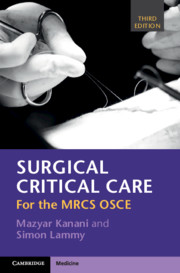Book contents
- Surgical Critical Care
- Reviews
- Surgical Critical Care
- Copyright page
- Dedication
- Contents
- Acknowledgements
- Abbreviations
- Section 1 Ward Care (Level 0–2)
- Chapter 1 Airway
- Chapter 2 Breathing
- Chapter 3 Circulation
- Chapter 4 Disability (Neurological Evaluation)
- Chapter 5 Exposure (Everything Else)
- Section 2 Intensive Care (Level 3)
- Index
- References
Chapter 2 - Breathing
from Section 1 - Ward Care (Level 0–2)
Published online by Cambridge University Press: 05 February 2021
- Surgical Critical Care
- Reviews
- Surgical Critical Care
- Copyright page
- Dedication
- Contents
- Acknowledgements
- Abbreviations
- Section 1 Ward Care (Level 0–2)
- Chapter 1 Airway
- Chapter 2 Breathing
- Chapter 3 Circulation
- Chapter 4 Disability (Neurological Evaluation)
- Chapter 5 Exposure (Everything Else)
- Section 2 Intensive Care (Level 3)
- Index
- References
Summary
The functional residual capacity is the volume of gas remaining in the lung at the end of quiet expiration. The normal range is 2.5–3.0 L.
- Type
- Chapter
- Information
- Surgical Critical CareFor the MRCS OSCE, pp. 22 - 71Publisher: Cambridge University PressPrint publication year: 2021



